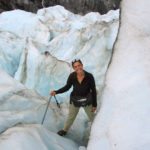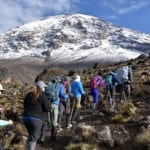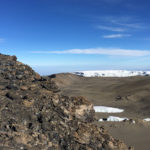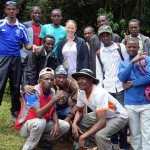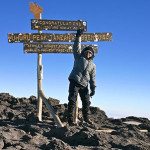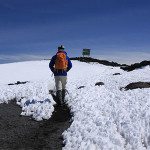
How do I train to summit Kilimanjaro? That’s a question we’re all-too familiar with. Some newer adventurers look at the 19,341-foot peak with doubt, and to be sure, Kili is a formidable challenge. However, summiting may be easier than you think with the correct tactics and moderate but consistent preparation.
Moderate is the key term here. There are often trekkers that put too much emphasis on “perfect” preparation regimens, and that game pulls them to extremes. One of those extremes is looking for a physical experience that perfectly reflects the experience of a Kilimanjaro climb.
Sounds reasonable, right? From crisis response to standardized testing, teachers and tutors will often tell you the best way to achieve an objective is training, drilling and simulating the situation as closely as possible. Unfortunately, this is easier said than done when your objective is summiting Africa’s tallest peak.
In the following, we’ll discuss some specific challenges that make Kilimanjaro summit simulation difficult, and we’ll offer some more practical alternatives and advice. Before that, let’s consider some context.
Climbing Kilimanjaro may be easier than you think
You might be saying, “Kilimanjaro is an easy climb? That’s absolutely ridiculous.” We agree! Kilimanjaro is not easy, but it is often easier than some think. Here’s why.
Kilimanjaro requires no special equipment or “climbing” in the traditional sense. The same skills you use during a hike are all that’s required to summit. The routes, albeit steep, contain no portions over 50% in grade. In fact, the more moderate terrain has allowed several climbers in their 70s and 80s to summit successfully.
With the appropriate tactics and strategy, summit success rates increase dramatically. In other words, your summit method and support system are often a greater indicator of summit success than the time you put into prep.
Case in point, Thomson trekkers have a 98% summit success rate. That’s because our climbing schedules offer more time to acclimatize and use a porter network that provides unlimited purified water, well-prepared food and comfortable sleeping quarters. You’re given a solid foundation for success. Without this, summit success rates plummet regardless of prep.
For perspective, 45% of all climbers across all routes successfully reach Kilimanjaro’s summit, according to Kilimanjaro National Park figures.
In sum, training is very important, but overdoing it will not ensure your success, so don’t go overboard. Now let’s talk about challenges on Kilimanjaro and how you can reasonably prepare.
Preparing for Kilimanjaro altitude
Just above 19,000 feet, the air pressure at Kilimanjaro’s summit is roughly 46% of what it would be at sea level, meaning you’re taking in less than half as much oxygen per breath as normal. This is the biggest obstacle for Kilimanjaro climbers, and unfortunately it’s the hardest to prepare for – thanks in part to a common misconception.

DON’T Mix up Training to Climb with Altitude Training
Altitude training is what some elite athletes do to prepare for competitions. It involves training at a high altitude – typically between 5,000 and 8,000 feet – and competing at a lower altitude. It has nothing to do with training to combat the effects of altitude sickness.
In fact, you can’t train against the effects caused by high altitude because your experience has nothing to do with your level of fitness. This is one reason acclimatization strategies on the mountain are critical to your success.

DO Learn about Altitude’s Effects
Studying the effects altitude will have on your body is the best “training” there is. Spotting the symptoms can be incredibly helpful for pacing, and taking necessary precautions. Commonly, Kilimanjaro trekkers can experience low appetite, nausea and headaches due to the altitude.
It shouldn’t be all on you, though. Climbing with an experienced Wilderness First Responder-certified guide will ensure you and your party is checked for signs of altitude sickness frequently and effectively.
Physical Conditioning and Training for Kilimanjaro
Summiting Kilimanjaro requires a fair amount of strength and endurance, but climbers sometimes get lost in the bigger picture. Kilimanjaro is not conquered in a day. The trek is spread across several days of hiking for various amounts of time across various distances and elevations.
Let’s use an example for perspective. Keep in mind, there are an infinite number of ways you can summit Kilimanjaro. We’ll use figures from our Western Approach Route as a baseline because it’s received positive reviews from climbing novices and veterans alike:
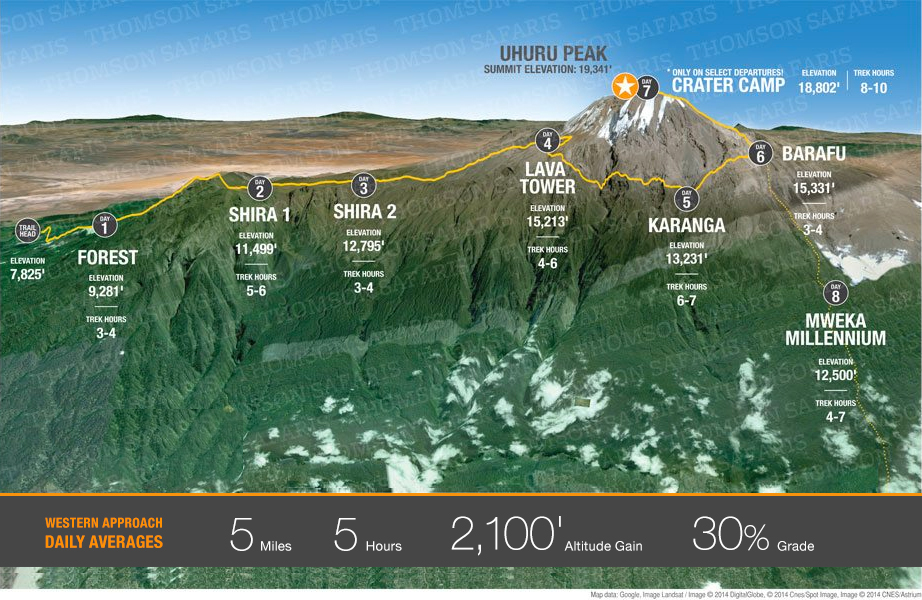
- Average distance hiked per day: 5 miles
- Average amount of time hiking per day: 5 hours
- Average gain per day during ascent: 2,100 feet
- Average grade: 30%
- Baggage weight carried: 15-20 pounds
TOTAL MILEAGE: 45 miles
Consider these figures for endurance purposes but remember that averages only tell part of the picture. Setting your treadmill to a 30% incline at 1 mph won’t give you a perfectly accurate experience because the terrain can change dramatically from day-to-day.
To that end, let’s consider the steepest, most challenging portion of the journey – the trek from Barafu Camp to the Uhuru Peak. This is the very last leg of the ascent.
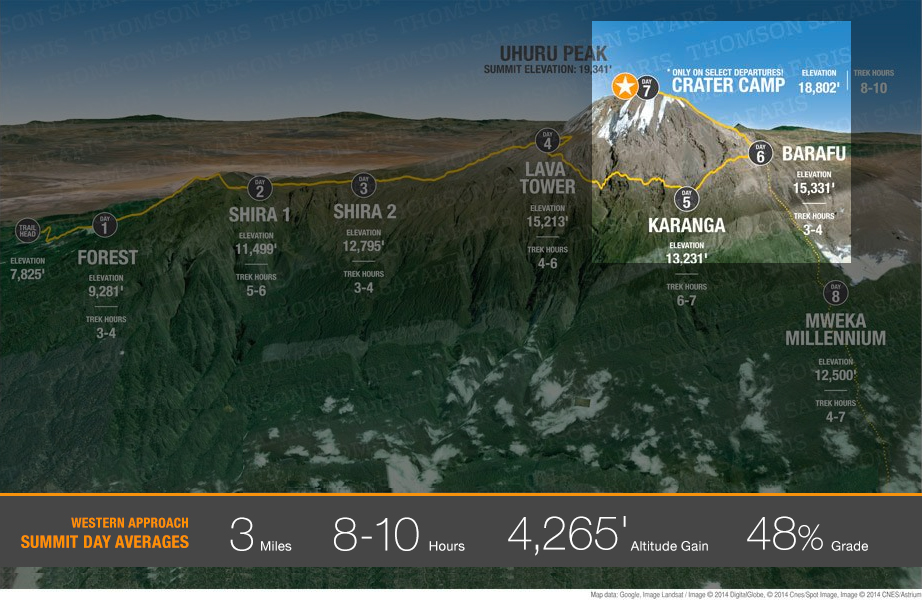
- Distance to hike: 3 miles
- Average amount of time hiking: 8-10 hours
- Gain: 4,265 feet
- Grade: 45-50%
Altitude is no small part of the difficulty experienced in this portion, but the steep grade should draw your attention as well. Keep this in mind while training.

DON’T Center Your Training Around One Grand Experience
From time to time, we find climbers who believe it’s necessary to climb comparable summits to prepare for Kilimanjaro. In short, this is a nice idea but ultimately not necessary. Sometimes this mindset can even create an obstacle for the truly valuable preparation as well.
First, a summit may be comparable but your experience likely won’t be. All peaks of similar heights with Kilimanjaro in the U.S. are in Alaska with a far different environment and less access. Even with a shorter, more accessible peak, you would have to mirror Kilimanjaro’s porter support system and the trek length to make the training similar and worth the effort, which is an economic and logistic impossibility for the great majority.
Second, physical conditioning requires training over a fair amount of time. All other obstacles aside, the physical benefits from one perfectly simulated exercise will do you less good than lesser efforts over greater time.
DO Practical and Consistent Simulated Aerobic Exercises
Aerobic exercise that builds endurance and strength is hugely valuable for your prep, but here are some specific guidelines.
Train for 3-5 days per week – consistency is critical in any physical training.
Cardio exercise will provide the greatest benefit for trekking. Hiking, swimming, jogging and cycling are all great activities.
Simulating practically can be a huge help. For example, hiking trails with plenty of steep inclines are perfect. However, if you don’t live close to such trails, adjusting the incline on a treadmill or using a Stairmaster and wearing a 15-20-pound weighted pack can be just as beneficial. Shoot for exercises that are not only like Kilimanjaro trekking but are realistic for you to undertake from day-to-day.
Some of our guests consider hiring a personal trainer to maximize results before trekking, which is a great idea! We recommend Fit For Trips, and you can get 25% off your program as a Thomson trekker.
Mental Preparation
Finally, remember that your attitude can have an impact on your success in prepping and in summiting. Climbing can take a great deal of willpower, especially in the final phases after Barafu Camp. Visualize yourself at the summit, and remember that you have all the tools necessary to get there.
We’ve had the honor of helping hundreds of inspiring people conquer Kilimanjaro. There’s nothing stopping you from joining their ranks.

